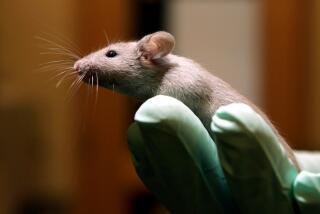Midget Mice Created in Study of Hormone
- Share via
A new strain of midget mice that are only half normal size has been developed by Ohio University researchers who accomplished the feat by modifying the gene for a growth hormone and inserting it into the animals, the scientists report today.
The researchers say the technique should work for any animal, so it should be possible to develop small rodents, pigs and other laboratory animals that would require less space and food.
The new discovery may also lead to the development of smaller farm animals that would use food more efficiently, and perhaps even to the development of new drug treatments for human gigantism.
The Ohio research also represents “an important step” in understanding the mechanisms by which cells are stimulated to grow, according to reproductive biologist Neal L. First of the University of Wisconsin. “This is one piece in a whole puzzle that is going to allow us to understand the growth hormone exactly,” First said.
Ohio molecular biologists John J. Kopchick and Wen Y. Chen were not trying to make small mice, Kopchick said in an interview. Instead, they were trying to produce unusually large mice.
They were building on work conducted in the early 1980s by researchers such as Ralph Brinster of the University of Pennsylvania and Richard Palmiter of the University of Washington.
Brinster and Palmiter found that they could produce mice that were twice normal size by using genetic engineering techniques to insert a growth hormone from cows, called bovine growth hormone or bGH, into the genes of mice. The extra growth hormone produced by the mice stimulated their growth.
Kopchick and Chen hoped to make the mice grow even bigger by making three small changes in the structure of bGH before inserting it into mouse embryos. They thought the changes might make it a more powerful growth stimulant.
“Surprisingly, instead of enhancing growth rate, these mutations suppressed the growth rate of the mouse,” Kopchick said. “They are normal in every way except size,” he said. The researchers now have “over a dozen” different “founder” mice, produced independently, that have been progenitors of strains of midget mice. Some of the strains are now in the third generation.
The “most exciting scientific aspect” of the research, Kopchick said, is the light it sheds on the growth process. Growth hormones normally bind to specific sites on the surface of cells, called receptors, thereby stimulating a chemical reaction within the cell that leads to growth.
The altered bGH produced by Kopchick and Chen also binds to that receptor. Surprisingly, however, it does not stimulate growth; it simply sits in the receptor. Because the altered bGH is occupying the receptors, normal mouse growth hormone cannot bind and stimulate growth, so that mouse growth is impaired.
By allowing researchers to separate the two functions of binding to cells and stimulating growth, the altered hormone thus provides a valuable tool to explore the actual chemical changes within the cell that lead to growth.
The Ohio researchers have not yet tried the altered hormone with any other animals, but “I am confident it will work in all mammals,” Kopchick said.
The work is published in today’s edition of the Proceedings of the National Academy of Sciences.




